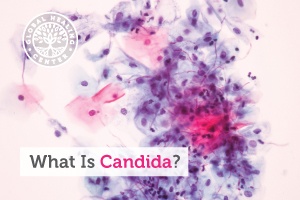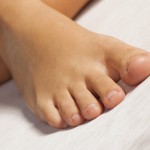
Candida is a type of fungus (or, more specifically – yeast) that can cause fungal infections like candidiasis, candidemia, and oral thrush.[1] Dozens of species of candida are known to affect humans and Candida albicans is the most common.[2, 3] When the immune system functions normally, Candida is kept in check and exists harmlessly in the skin or mucous membranes like those of the gut and vaginal area. It’s even among the organisms that newborns acquire during natural birth, nursing, or from food.[4] However, a compromised immune system, and other factors such as poor diet, can lead to an imbalance where Candida overwhelms the body, a condition known as Candida overgrowth.
What Is Candida Overgrowth?
Everyone has some form of Candida in their body; it’s normal and not necessarily a health concern. The immune system typically keeps Candida in balance but lifestyle, health conditions, or other factors can trigger Candida overgrowth where the yeast multiplies and negatively affects the body’s normal processes. A Candida overgrowth can result in a myriad of concerns, including infection of the skin, throat, esophagus, blood, or genitals.[5, 6] A Candida overgrowth can disrupt the beneficial bacteria in the body. Candida cylindracea, for example, is important for digestion because of its enzymatic properties and pH levels.[7] An overgrowth, however, can disrupt the entire gut microbiota. Candida overgrowth can even contribute to leaky gut syndrome,[8] a condition where the protective barrier known as the intestinal mucosa becomes perforated with tiny holes that allow the contents of the digestive tract to leak into the bloodstream.
What Causes Candida Overgrowth?
There are a number of factors that can act as a catalyst for Candida overgrowth. Some of the most common include:
Antibiotics
Antibiotics attack all bacteria — good and bad — and upset the body’s internal balance in a big way. This disruption can harm the microbiome, allowing Candida to spread and cause infections.[1]
Alcohol
Chronic alcohol consumption can foster the overgrowth of certain species of Candida. This causes an imbalance in the body and can lead to health concerns.[9]
Weak Immune System
The immune system helps keep Candida in check but a compromised immune system can open the door for Candida overgrowth. Many medical conditions and medications can affect the immune system.[10, 11, 12]
Diabetes
Candida overgrowth is common in individuals with diabetes. High blood glucose (hyperglycemia) affects the immune system, reduces the antibacterial activity of urine, and impedes the digestive and urinary systems.[1, 13]
Health Conditions and Other Factors
Other factors that may put you at risk of candida overgrowth include:[14, 15]
- Organ transplantation
- Wearing dentures
- Suffering from kidney failure or being on hemodialysis
- Pregnancy
- Being a patient in the intensive care unit
10 Species of Candida You Should Know
There are many different species of Candida and each interacts with the body in its own way.[16] Here are ten of the most common types of Candida and how they can affect your health.
1. Candida albicans
Known as an “opportunist” fungi, Candida albicans is responsible for the majority of fungal infections in humans.[17] Although Candida albicans is usually harmless,[18] unchecked it can disrupt normal physiological processes. Vaginal yeast infections and oral thrush are among its most common effects.
2. Candida glabrata
Candida glabrata exists in mucosal tissues. In recent years, mucosal and systemic infections caused by Candida glabrata have dramatically increased.[19] It is now the second-leading cause of Candida infection behind Candida albicans.
3. Candida parapsilosis
Candida parapsilosis is best known for causing infection among newborns and patients under intensive care.[20] Because one of the most common ways for Candida parapsilosis to spread is through hand contact with healthcare professionals, it is a major concern in hospitals.[21]
4. Candida krusei
Candida krusei is a concern for patients who suffer from malignancies in the blood or who have received transplants. Candida krusei can lead to serious infections in the bloodstream. The transmission of this particular organism has become the subject of further study, as the frequency of Candida krusei infections vary with geographical and temporal trends.[22]
5. Candida dubliniensis
Candida dubliniensis, which is structurally similar to Candida albicans, has been identified in the mouths of patients with HIV or AIDS.[23] It has also been found in the genital tracts of HIV-negative immunocompromised individuals and women suffering from vaginitis.[24]
6. Candida lusitaniae
Also considered an opportunistic yeast, Candida lusitaniae has been associated with infection in leukemia patients.[25] Additionally, Candida lusitaniae is known for its resistance to the antifungal drug amphotericin.[26] Resistance is uncommon among species of candida, making it one of the specimen’s defining traits.
7. Candida guilliermondii
Although uncommon and one of the lesser known species of Candida, Candida guilliermondii can strike immunocompromised persons.[27] What we do know is that it is a rare and invasive specimen that has demonstrated a reduced susceptibility to antifungal agents.[28]
8. Candida rugosa
Similar to Candida krusei, Candida rugosa is a fungal pathogen that has demonstrated unique geographic and temporal trends.[29] In recent years, it has been identified as the cause of candidemia in some patients.[30] Like Candida krusei and Candida glabrata, Candida rugosa is resistant to some antifungal treatments.[31]
9. Candida zeylanoides
Found in skin, nail, and blood samples, Candida zeylanoides has been reported as the source of fungemia — yeast in the blood.[32][33] It may be treated with intravenous amphotericin therapy.[34]
10. Candida tropicalis
Frequently encountered in tropical climates and known to cause candidemia, Candida tropicalis is one of the more common species of Candida known to affect humans.[35] A major concern with the specimen’s global presence is its resistance to treatment with fluconazole.[36]
How to Get Rid of Candida
If you recognize the symptoms of yeast infection or any other malady related to a Candida overgrowth, it’s important to act fast. Natural remedies such as tea tree oil,[37] star anise,[38] and eucalyptus[39] have a natural ability to fight out-of-control fungus and support the body’s processes to restore balance. Diet can also be an excellent solution to eliminating candida. Try the ultimate candida diet program for long-lasting results.
References (39)
- MedlinePlus. Candida infection of the skin.
- Kim J, Sudbery P. Candida albicans, a major human fungal pathogen. J Microbiol. 2011 Apr;49(2):171-7. doi: 10.1007/s12275-011-1064-7. Epub 2011 May 3.
- CDC. Candidiasis.
- Jenkinson H, Douglas J. Polymicrobial Diseases. Washington (DC): ASM Press; 2002.
- MedlinePlus. Yeast Infections.
- Aubyn G, Tagoe D. Prevalence of vaginal infections and associated lifestyles of students in the university of Cape Coast, Ghana. Asian Pac J Trop Dis. 2013 Aug; 3(4): 267–270.
- Fieker A, Philpott J, Armand M. Enzyme replacement therapy for pancreatic insufficiency: present and future. Clin Exp Gastroenterol. 2011; 4: 55–73.
- Schulz J, Sonnenborn U. Yeasts in the Gut: From Commensals to Infectious Agents. Dtsch Arztebl Int. 2009 Dec; 106(51-52): 837–842.
- Choi J, Lee C, Lim Y, Kang H, Lim C, Choi JS. Prevalence and Risk Factors of Esophageal Candidiasis in Healthy Individuals: A Single Center Experience in Korea. Yonsei Med J. 2013 Jan 1; 54(1): 160–165.
- Maksymiuk AW, Thongprasert S, Hopfer R, Luna M, Fainstein V, Bodey GP. Systemic candidiasis in cancer patients. Am J Med. 1984 Oct 30;77(4D):20-7.
- Fichtenbaum C, Aberg J. Candidiasis and HIV. HIV InSite Knowledge Base Chapter.
- CDC. Medications that Weaken Your Immune System and Fungal Infections.
- Casqueiro J, Casqueiro J, Alves C. Infections in patients with diabetes mellitus: A review of pathogenesis. Indian J Endocrinol Metab. 2012 Mar; 16(Suppl1): S27–S36.
- CDC. Invasive Candidiasis Risk & Prevention.
- CDC. Oropharyngeal / Esophageal Candidiasis ("Thrush”).
- Rossignol T, Lechat P, Cuomo C, Zeng Q, Moszer I, d’Enfer C. CandidaDB: a multi-genome database for Candida species and related Saccharomycotina. Nucleic Acids Res. 2008 Jan; 36(Database issue): D557–D561.
- Dupont PF. Candida albicans, the opportunist. A cellular and molecular perspective. J Am Podiatr Med Assoc. 1995 Feb;85(2):104-15.
- Kumamoto C. Inflammation and gastrointestinal Candida colonization. Curr Opin Microbiol. 2011 Aug; 14(4): 386–391.
- Fidel P, Vazquez J, Sobel J. Candida glabrata: Review of Epidemiology, Pathogenesis, and Clinical Disease with Comparison to C. albicans. Clin Microbiol Rev. 1999 Jan; 12(1): 80–96.
- Trofa D, Gacser A, Nosanchuk J. Candida parapsilosis, an Emerging Fungal Pathogen. Clin Microbiol Rev. 2008 Oct; 21(4): 606–625.
- Kuhn D, Mukherjee P, Clark T, Pujol C, Chandra J, Hajjeh R, Warnock D, Soll D, Ghannoum M. Candida parapsilosis Characterization in an Outbreak Setting. Emerging Infectious Diseases • www.cdc.gov/eid • Vol. 10, No. 6, June 2004.
- Pfaller MA, Diekema DJ, Gibbs DL, Newell VA, Nagy E, Dobiasova S, Rinaldi M, Barton R, Veselov A; Global Antifungal Surveillance Group. Candida krusei, a multidrug-resistant opportunistic fungal pathogen: geographic and temporal trends from the ARTEMIS DISK Antifungal Surveillance Program, 2001 to 2005. J Clin Microbiol. 2008 Feb;46(2):515-21. Epub 2007 Dec 12.
- Sullivan D, Coleman D. Candida dubliniensis: Characteristics and Identification. J Clin Microbiol. 1998 Feb; 36(2): 329–334.
- Brandt M, Harrison L, Pass M, Sofair A, Huie S, Li RK, Morrison C, Warnock D, Hajjeh R. Candida dubliniensis Fungemia: the First Four Cases in North America. Emerging Infectious Diseases. Vol. 6, No. 1, January–February 2000.
- Honschu DL, Presley HL, Miranda M, Pfaff HJ. Identification of Candida lusitaniae as an opportunistic yeast in humans. J Clin Microbiol. 1979 Aug; 10(2): 202–205.
- Sanchez V. Vazquez J, Barth-Jones D, Dembry L, Sobel J, Zervos M. Epidemiology of Nosocomial Acquisition of Candida lusitaniae. JOURNAL OF CLINICAL MICROBIOLOGY, Nov. 1992, p. 3005-3008.
- Girmenia C, Pizzarelli G, Cristini F, Barchiesi F, Spreghini E, Scalise G, Martino P. Candida guilliermondii Fungemia in Patients with Hematologic Malignancies. J Clin Microbiol. 2006 Jul; 44(7): 2458–2464.
- Pfaller MA, Diekema DJ, Mendez M, Kibbler C, Erzsebet P, Chang SC, Gibbs DL, Newell VA. Candida guilliermondii, an Opportunistic Fungal Pathogen with Decreased Susceptibility to Fluconazole: Geographic and Temporal Trends from the ARTEMIS DISK Antifungal Surveillance Program. J Clin Microbiol. 2006 Oct; 44(10): 3551–3556.
- Pfaller MA, Diekema DJ, Mendez M, Kibbler C, Erzsebet P, Chang SC, Gibbs DL, Newell VA. Candida rugosa, an Opportunistic Fungal Pathogen with Decreased Susceptibility to Fluconazole: Geographic and Temporal Trends from the ARTEMIS DISK Antifungal Surveillance Program. J Clin Microbiol. 2006 Oct; 44(10): 3578–3582.
- Behera B, Singh RI, Xess I, Mathur P, Hasan F, Misra MC. Candida rugosa: a possible emerging cause of candidaemia in trauma patients. Infection. 2010 Oct;38(5):387-93. doi: 10.1007/s15010-010-0044-x. Epub 2010 Jul 24.
- Pfaller MA, Diekema DJ, Colombo AL, Kibbler C, Ng KP, Gibbs DL, Newell VA. Candida rugosa, an emerging fungal pathogen with resistance to azoles: geographic and temporal trends from the ARTEMIS DISK antifungal surveillance program. J Clin Microbiol. 2006 Oct;44(10):3578-82.
- Levenson D, Pfaller MA, Smith MA, Hollis R, Gerarden T, Tucci CB, Isenburg HD. Candida zeylanoides: another opportunistic yeast. J Clin Microbiol. 1991 Aug; 29(8): 1689–1692.
- Hazen K. New and Emerging Yeast Pathogens. CLINICAL MICROBIOLOGY REVIEWS, Oct. 1995, p. 462–478.
- Bisbe J, Vilardell J, Valls M, Moreno A, Brancos M, Andreu J. Transient fungemia and Candida arthritis due to Candida zeylanoides. Eur J Clin Microbiol. 1987 Dec;6(6):668-9.
- Chai LY, Denning DW, Warn P. Candida tropicalis in human disease. Crit Rev Microbiol. 2010 Nov;36(4):282-98. doi: 10.3109/1040841X.2010.489506.
- Kothavade RJ, Kura MM, Valand AG, Panthaki MH. Candida tropicalis: its prevalence, pathogenicity and increasing resistance to fluconazole. J Med Microbiol. 2010 Aug;59(Pt 8):873-80. doi: 10.1099/jmm.0.013227-0. Epub 2010 Apr 22.
- Martin KW, Ernst E. Herbal medicines for treatment of fungal infections: a systematic review of controlled clinical trials. Mycoses. 2004 Apr;47(3-4):87-92.
- De M, De AK, Sen P, Banerjee AB. Antimicrobial properties of star anise (Illicium verum Hook f). Phytother Res. 2002 Feb;16(1):94-5.
- Shahi SK, Shukla AC, Bajaj AK, Banerjee U, Rimek D, Midgely G, Dikshit A. Broad spectrum herbal therapy against superficial fungal infections. Skin Pharmacol Appl Skin Physiol. 2000 Jan-Feb;13(1):60-4.
†Results may vary. Information and statements made are for education purposes and are not intended to replace the advice of your doctor. If you have a severe medical condition or health concern, see your physician.







